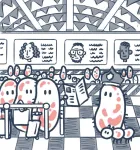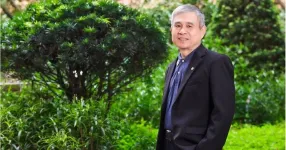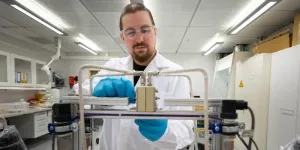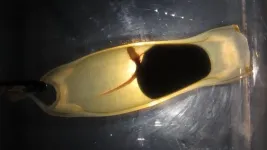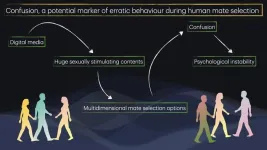(Press-News.org) A new way to map the spread and evolution of pathogens, and their responses to vaccines and antibiotics, will provide key insights to help predict and prevent future outbreaks. The approach combines a pathogen’s genomic data with human travel patterns, taken from anonymised mobile phone data.
Researchers from the Wellcome Sanger Institute, University of the Witwatersrand and National Institute for Communicable Diseases in South Africa, the University of Cambridge, and partners across the Global Pneumococcal Sequencing project1, integrated genomic data from nearly 7,000 Streptococcus pneumoniae (pneumococcus) samples collected in South Africa with detailed human mobility data2. This enabled them to see how these bacteria, which cause pneumonia and meningitis3, move between regions and evolve over time.
The findings, published today (3 July) in Nature, suggest initial reductions in antibiotic resistance linked to the 2009 pneumococcal vaccine may be only temporary, as non-targeted strains resistant to antibiotics such as penicillin gained a 68 per cent competitive advantage.
This is the first time researchers have been able to precisely quantify the fitness – their ability to survive and reproduce – of different pneumococcal strains. The insight could inform vaccine development to target the most harmful strains, and may be applicable to other pathogens.
Many infectious diseases such as tuberculosis, HIV, and COVID-19 exist in multiple strains or variants circulating simultaneously, making them difficult to study. Pneumococcus, a bacterium that is a leading cause of pneumonia, meningitis, and sepsis worldwide4, is a prime example with over 100 types and 900 genetic strains globally. Pneumonia alone kills around 740,000 children under the age of five each year5, making it the single largest infectious cause of death in children.
Pneumococcal diversity hampers control efforts, as vaccines targeting major strains leave room for others to fill the vacant niches. How these bacteria spread, how vaccines affect their survival, and their resistance to antibiotics remains poorly understood.
In this new study, researchers analysed genome sequences from 6,910 pneumococcus samples collected in South Africa between 2000 and 2014 to track the distribution of different strains over time. They combined these data with anonymised records of human travel patterns collected by Meta2.
The team developed computational models which revealed pneumococcal strains take around 50 years to fully mix throughout South Africa’s population, largely due to localised human movement patterns.
They found that while introduction of a pneumococcal vaccine against certain types of these bacteria in 2009 reduced the number of cases caused by those types6, it also made other non-targeted strains of these bacteria gain a 68 per cent competitive advantage, with an increasing proportion of them becoming resistant to antibiotics such as penicillin. This suggests that the vaccine-linked protection against antibiotic resistance is short-lived.
Dr Sophie Belman, first author of the study, former PhD student at the Wellcome Sanger Institute and now a Schmidt Science Fellow at the Barcelona Supercomputing Centre, Spain, said: “While we found that pneumococcal bacteria generally spread slowly, the use of vaccines and antimicrobials can quickly and significantly change these dynamics. Our models could be applied to other regions and pathogens to better understand and predict pathogen spread, in the context of drug resistance and vaccine effectiveness.”
Dr Anne von Gottberg, author of the study at National Institute for Communicable Diseases, Johannesburg, South Africa, said: “Despite vaccination efforts, pneumonia remains one of the leading causes of death for children under five in South Africa. With continuous genomic surveillance and adaptable vaccination strategies to counter the remarkable adaptability of these pathogens, we may be able to better target interventions to limit the burden of disease.”
Professor Stephen Bentley, senior author of the study at the Wellcome Sanger Institute, said: “The pneumococcus's diversity has obscured our view on how any given strain spreads from one region to the next. This integrated approach using bacterial genome and human travel data finally allows us to cut through that complexity, uncovering hidden migratory paths in high-definition for the first time. This could allow researchers to anticipate where emerging high-risk strains may take hold next, putting us a step ahead of potential outbreaks.”
ENDS
Notes to Editors:
Partners from the Global Pneumococcal Sequencing project can be found here: https://www.pneumogen.net/gps/
The human mobility data used in this study are Meta Data for Good baseline data, released during the 2020 SARS-CoV-2 pandemic. These data rely on personal consent for location sharing, and Data for Good ensures individual privacy by preventing re-identification in aggregated datasets.
For more information on the Movement Range Maps, access: https://dataforgood.fb.com/tools/movement-range-maps/
For more information on privacy matters, access: https://about.fb.com/news/2020/06/privacy-matters-data-for-good/
For more information on pneumococcal disease, visit: https://www.cdc.gov/pneumococcal/about/index.html
https://www.ncbi.nlm.nih.gov/pmc/articles/PMC5666185/
https://www.who.int/news-room/fact-sheets/detail/pneumonia
Before these vaccines, 85 per cent of pneumococcal strains were those targeted by the vaccines. By 2014, this dropped to 33.2 per cent. This change was consistent across all nine provinces in South Africa.
These data can be accessed here: https://github.com/sophbel/geomig_evo_pneumo
Publication:
S. Belman et al. (2024) ‘Geographic Migration and Fitness Dynamics of Streptococcus pneumonia.’ Nature. DOI: 10.1038/s41586-024-07626-3
Funding:
This research was supported by Wellcome, the Bill and Melinda Gates Foundation, NIH and the European Research Council. For full funding acknowledgements, please refer to the publication.
END
Mobile phone data helps track pathogen spread and evolution of superbugs
Combining genomic data and human travel patterns over a 14-year period in South Africa reveals key insights into the spread, evolution and resistance patterns of a major bacterium behind pneumonia and meningitis globally
2024-07-03
ELSE PRESS RELEASES FROM THIS DATE:
Discovery of cellular mechanism to maintain brain’s energy could benefit late-life brain health
2024-07-03
A key mechanism which detects when the brain needs an additional energy boost to support its activity has been identified in a study in mice and cells led by UCL scientists.
The scientists say their findings, published in Nature, could inform new therapies to maintain brain health and longevity, as other studies have found that brain energy metabolism can become impaired late in life and contribute to cognitive decline and the development of neurodegenerative disease.
Lead author Professor Alexander Gourine (UCL Neuroscience, ...
Extinct humans survived on the Tibetan plateau for 160,000 years
2024-07-03
Bone remains found in a Tibetan cave 3,280 m above sea level indicate an ancient group of humans survived here for many millennia, according to a new study published in Nature.
The Denisovans are an extinct species of ancient human that lived at the same time and in the same places as Neanderthals and Homo sapiens. Only a handful Denisovan remains have ever been discovered by archaeologists. Little is known about the group, including when they became extinct, but evidence exists to ...
PolyU study reveals the mechanism of bio-inspired control of liquid flow, enlightening breakthroughs in fluid dynamics and nature-inspired materials technologies
2024-07-03
The more we discover about the natural world, the more we find that nature is the greatest engineer. Past research believed that liquids can only be transported in fixed direction on species with specific liquid communication properties and cannot switch the transport direction. Recently, The Hong Kong Polytechnic University (PolyU) researchers have shown that an African plant controls water movement in a previously unknown way – and this could inspire breakthroughs in a range of technologies in fluid dynamics and nature-inspired materials, including applications that require multistep and repeated reactions, such as microassays, medical ...
Early-onset El Niño means warmer winters in East Asia, and vice versa
2024-07-03
Fukuoka, Japan—The phenomenon known as El Niño can cause abnormal and extreme climate around the world due to it dramatically altering the normal flow of the atmosphere. In Japan, historical data has shown that El Niño years tend to lead to warmer winters. This case was exemplified recently with Japan’s warm 2023-2024 winter season. However, there have also been cases of cold winters in Japan during El Niño years, such as the one recorded in 2014-2015. Yet, it was unclear as to why this was occurring.
Publishing in the Journal of Climate, ...
How to avoid wasting huge amounts of energy
2024-07-03
Norway wastes huge amounts of energy. Surplus heat produced by industry is hardly exploited at all.
Researchers at the Norwegian University of Science and Technology (NTNU) have been looking at the possibilities for doing something about this.
“Surplus heat from industrial processes is a huge resource,” says Kim Kristiansen.
He has just completed his PhD on a technology that can harness some of the surplus heat that currently goes to waste. Almost all the heat generated by industrial processes is currently released directly into the air or the ocean, and we are not talking about small amounts. In Norway alone, industry produces ...
Bowel cancer turns genetic switches on and off to outwit the immune system
2024-07-03
Bowel cancer cells have the ability to regulate their growth using a genetic on-off switch to maximise their chances of survival, a phenomenon that’s been observed for the first time by researchers at UCL and University Medical Center Utrecht.
The number of genetic mutations in a cancer cell was previously thought to be purely down to chance. But a new study, published in Nature Genetics, has provided insights into how cancers navigate an “evolutionary balancing act”.
The researchers found that mutations in DNA repair genes can be repeatedly created and repaired, acting as ‘genetic switches’ that take the brakes off a tumour’s growth ...
Shark hatching success drops from 82% to 11% in climate change scenario
2024-07-03
New experimental research shows that the combined effects of ocean warming and acidification could lead to a catastrophic decrease in embryonic shark survival by the year 2100. This research is also the first to demonstrate that monthly temperature variation plays a prominent role in shark embryo mortality.
Oceanic warming and acidification are caused by greater concentrations of CO2 dissolving into marine environments, resulting in rising water temperatures and falling pH levels. “The embryos of egg-laying ...
Meet the team 3D modelling France’s natural history collections
2024-07-03
France’s natural history collections contain nearly 6% of the world’s total natural specimens across multiple institutions, and the e-COL+ project aims to capture and reconstruct these specimens in 3D for easy access and 3D printing around the world.
“I’m a researcher of vertebrate locomotion and vocalisation, so I produce a lot of CT scans and 3D models – and now I’m in charge of developing the museum’s own 3D digital collection,” ...
Artificial light is a deadly siren song for young fish
2024-07-03
New research finds that artificial light at night (ALAN) attracts larval fish away from naturally lit habitats, while dramatically lowering their chances of survival in an “ecological trap”, with serious consequences for fish conservation and fishing stock management.
“Light pollution is a huge ongoing subject with many aspects that are still not well understood by scientists,” says Mr Jules Schligler, a PhD student at CRIOBE Laboratory (Centre de Recherches Insulaires et Observatoire de l’Environnement) in Moorea, French Polynesia.
ALAN is the product of human-related ...
Social media is a likely cause of ‘confusion’ in modern mate selection
2024-07-03
A recent sociological study finds that most young adults surveyed reported feeling confused about their options when it comes to dating decisions. Preliminary analysis suggests that more than half of young people experience confusion about choosing life-partners, with women appearing to be more likely to report partner selection confusion than men.
Due to the pervasiveness of social media and digital dating in everyday lives, humans are now exposed to many more potential mates than ever before, but the availability of popular dating apps ...
LAST 30 PRESS RELEASES:
This self-powered eye tracker harnesses energy from blinking and is as comfortable as everyday glasses
Adverse prenatal exposures linked to higher rates of mental health issues, brain changes in adolescents
Restoring mitochondria shows promise for treating chronic nerve pain
Nature study identifies a molecular switch that controls transitions between single-celled and multicellular forms
USU chemists' CRISPR discovery could lead to single diagnostic test for COVID, flu, RSV
Early hominins from Morocco reveal an African lineage near the root of Homo sapiens
Small chimps, big risks: What chimps show us about our own behavior
We finally know how the most common types of planets are created
Thirty-year risk of cardiovascular disease among healthy women according to clinical thresholds of lipoprotein(a)
Yoga for opioid withdrawal and autonomic regulation
Gene therapy ‘switch’ may offer non-addictive pain relief
Study shows your genes determine how fast your DNA mutates with age
Common brain parasite can infect your immune cells. Here's why that's probably OK
International experts connect infections and aging through cellular senescence
An AI–DFT integrated framework accelerates materials discovery and design
Twist to reshape, shift to transform: Bilayer structure enables multifunctional imaging
CUNY Graduate Center and its academic partners awarded more than $1M by Google.org to advance statewide AI education through the Empire AI consortium
Mount Sinai Health system receives $8.5 million NIH grant renewal to advance research on long-term outcomes in children with congenital heart disease
Researchers develop treatment for advanced prostate cancer that could eliminate severe side effects
Keck Medicine of USC names Christian Pass chief financial officer
Inflatable fabric robotic arm picks apples
MD Anderson and SOPHiA GENETICS announce strategic collaboration to accelerate AI-driven precision oncology
Oil residues can travel over 5,000 miles on ocean debris, study finds
Korea University researchers discover that cholesterol-lowering drug can overcome chemotherapy resistance in triple-negative breast cancer
Ushikuvirus: A newly discovered giant virus may offer clues to the origin of life
Boosting the cell’s own cleanup
Movement matters: Light activity led to better survival in diabetes, heart, kidney disease
Method developed to identify best treatment combinations for glioblastoma based on unique cellular targets
Self-guided behavioral app helps children with epilepsy sleep earlier
Higher consumption of food preservatives is associated with an increased risk of type 2 diabetes
[Press-News.org] Mobile phone data helps track pathogen spread and evolution of superbugsCombining genomic data and human travel patterns over a 14-year period in South Africa reveals key insights into the spread, evolution and resistance patterns of a major bacterium behind pneumonia and meningitis globally
